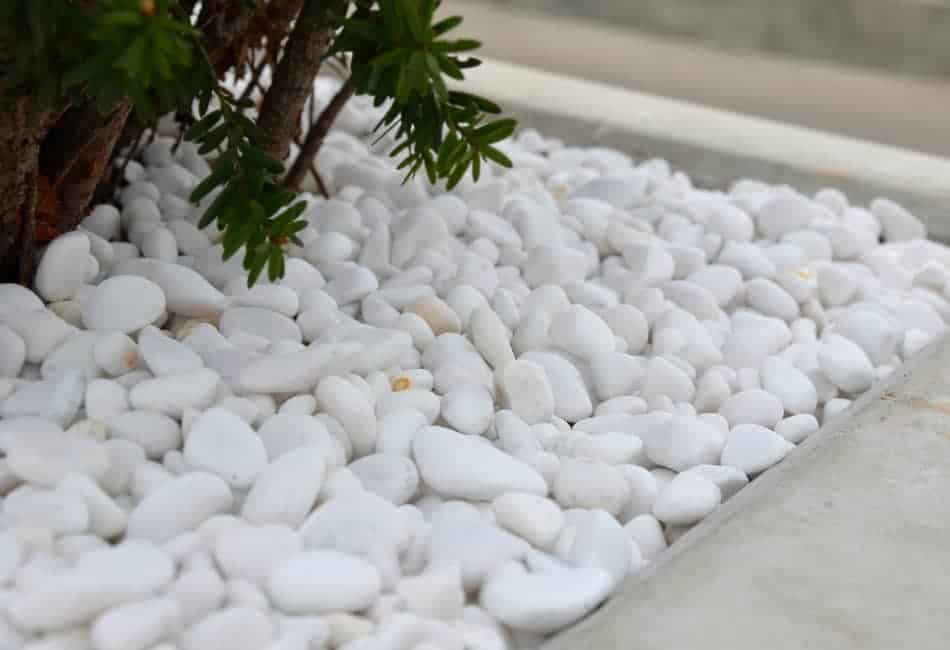Marble is one of the most expensive and luxurious natural stones in the world. The popularity of marble as a flooring material has led many people to wonder if it is safe for plants.
Marble floors are beautiful, but can they really support plant life? We will explore what you need to know about using marble as a surface for your plants in this blog post!
So is marble safe for plants? Below are the pros and cons of using marble with plants;
| The Pros | The Cons |
| Marble Can Be Used As An Edging Material | Marble Will Increase The Alkalinity Of The Plants Soil |
| Marble Is Durable | Marble Stone Can Leach Harmful Salts Into The Soil |
| Marble Has Beautiful appearance And Adds To The Architectural Value | Marble Chips In Soil Can Promote Mold And Other Moisture-Loving Fungus |
| Marble Prevents Dirt Accumulation | Some Marbles May Still Have Polishes That Could Hurt Plants |
| Marble Regulates Soil Temperature | Marble Will Develop Stains With Time |
While many people consider marble an expensive luxury item and may question whether or not it is safe for planting, there are actually benefits that come from using this stone in conjunction with living foliage. The cons of using marble surfaces should also be considered before making any decisions.
The Cons Of Using Marble For Your Plants
In order to make sure that every purchase decision is well informed and backed by research rather than hearsay, I have compiled all the information you need when considering marble for your plants. Let’s begin with the cons of using marble for your plants.
1. Marble Will Increase The Alkalinity Of The Plants Soil
One of the first reasons why marble chips are not good for plants is that the marble will increase the alkalinity of the plant’s soil.
Soil that is more alkaline can inhibit plant growth and development, as well as decrease their ability to intake vital nutrients like iron or zinc.
Not every plant can thrive in soil that is more alkaline, so it’s important to know which plants will be best suited for your marble chips before you decide to apply them to your plants.
There are a few different types of soil that gardeners can use in order to alleviate the alkalinity problem when using marble as an edging material.
One is called “soil-less” media because there is no dirt or organic materials included with these mixes; they consist mostly of peat moss and perlite, though some may also include vermiculite or sand as well.
Another option would be a mixture of ground pine bark mixed with peat moss: if the plant needs more acidity then water-treated wood ash could be added into the mix until the desired pH level has been reached – but do not add this too often or it will kill the plants.
Your best bet for rocks that are safe especially for plants that thrive in pH-neutral soils is river rocks or lava rocks. This is because these types of rocks are basically calcium and magnesium carbonate rocks, which are completely safe for plants.
“Vinca and jasmine will tolerate alkaline soil while hibiscus will not be able to live in it.”
2. Marble Stone Can Leach Harmful Salts Into The Soil
Another reason why marble is not safe for plants is that when plants are watered, the water will dissolve some of the marble’s minerals and create salts that can affect plant growth.
This is because when these chemicals come in contact with a plant’s roots they may prevent them from taking up oxygen or nutrients into their cells – effectively starving it, which can lead to root rot.
It is important to know that these salts can leach out of the soil, especially when it is watered.
Some plants may be more sensitive to these chemicals than others, so some species do not have a good idea for using marble stones in potting mix or on top of their roots.
One good example would be succulents because they have shallow root systems and will easily come into contact with any salt buildup near their surface.
This usually leaves them exposed to undue stress that could potentially kill the plant as well as prevent other nearby plants from thriving if there’s enough concentration found just below the surface.
But this does not mean all succulent species cannot grow at all – there are many varieties that thrive without too much water intake like Sempervivums and Kalanchoes.
3. Marble Chips In Soil Can Promote Mold And Other Moisture-Loving Fungus
Another problem is that when the marble chips are mixed into soil, they can promote mold growth and other moisture-loving fungi.
Mold spores will grow on wet surfaces such as leaves or moist soils, so if these plants are watered with a sprayer it could create an environment for fungus to thrive in.
There are reports that any moisture-loving fungus-like mold could be growing on marble surfaces if you had had them applied to your plants inside your home.
This means you’ll need to keep an eye out for symptoms of infection such as wilting leaves, yellowing leaves, or stunted growth.
All in all, it is important to add that marble chips are not a good choice for use in garden soil.
4. Some Marbles May Still Have Polishes That Could Hurt Plants
It is not advised to use some marble chips because the surface may have been polished with a material that could be toxic for your plants.
Marble tile also carries this danger as well, so it’s best if you stick to using rocks and other non-polished stones for your home garden or indoor pot plant project.
The chemicals that are present in these polishes such as ammonia, alcohol, and other solvents can be harmful to plants.
The surface of the marble may also contain crystalline silicates which will dissolve in water or react with acids from plant extracts such as tomato leaves.
These chemicals are bad for your plants because they create an environment that’s too acidic for the plants to grow well.
It is important you know what kind of stone you’ll use before using it in your indoor or outdoor garden so there isn’t any chance of harming your greenery.
5. Marble Will Develop Stains With Time
Marble will develop stains with time. For example, if you spill coffee on your marble countertop, the stain will be difficult to remove without professional help.
You may notice that sometimes these stains are not even noticed until the light hits them just right and they create an unsightly appearance in your kitchen or bathroom.
In the same way, when marble is used with plants especially outdoors, it will develop stains over time. It is important to remember that anything the marble comes into contact with (even water) could leave a mark on its surface, and it may be difficult or impossible to remove this stain without professional help.
Marble can be used outdoors as long as there’s plenty of drainage holes so excess liquids don’t stay stagnant below the container which would create an unsightly staining effect.
You’ll need porous soil like bark mulch or composted pine needles placed at least one inch deep inside the pot and topped off with gravel for good measure.
All in all, it’s also important to remember that not all stone is impervious to weathering because marble is susceptible to stains from rainwater so it should only be used in areas where there are no direct sources of precipitation such as patios and terraces which are typically covered by a roof.
The Pros of Using Marble With Your Plants
It is not all doom and gloom when it comes to using marble for your plants as some plants as mentioned before can do pretty fine with marble is used with them. Below are some of the benefits when you use marble with the right types of plants.
1. Marble Can Be Used As An Edging Material
One of the first pros that come to mind is that marble can be used as an edging material for your plants.
When you use marble as an edging material for your plants, it can add a personal touch to the overall design of the garden.
This is great because this will make people who visit your home notice that there was some thought put into the landscaping and not just thrown together.
The key benefit of using marble as an edging material is that it is not only attractive but also it is easy to work with when it comes to activities like shaping, cutting, installing, etc, can all be done by hand without any special tools or equipment.
2. Marble Is Durable
Another advantage of using marble for your garden or landscape is that it is tough and durable. Marbles’ being durable means that they won’t rot.
Its dense weight-bearing capacity makes it strong enough – so you don’t have to worry about heavy pots tipping over.
All the above-mentioned qualities can be beneficial in many ways because they will last for years without any need to refinish or replace the material, which saves time and money on maintenance costs.
It also makes it easy to place an edging around a garden that has plants of different heights. Marble’s durability is one of its best qualities when used as an edging material for your plants but there are cons with using this type of stone too so we’ll get into those next.
3. Marble Has Beautiful appearance And Adds To The Architectural Value
Marble has a beautiful appearance and adds to the architectural value of your home. As mentioned earlier, marble can be used as edging for plants or in any other spot that needs an attractive decoration like, benches, fountains, and planters.
The beauty of marble will stay with you for years without requiring much upkeep but this type of material isn’t appropriate in exposed locations due to its low resistance against moisture damage.
4. Marble Prevents Dirt Accumulation
Marble Is Non-Porous so it is able to prevent dirt from accumulating on top while still allowing the plant to breathe. It also has a higher resistance against fungi and bacteria when compared with terracotta or concrete that are porous materials.
Any dirt, grime, or spills will easily wipe off without the need for scrubbing since marble is easy to clean. This means less time spent caring for your plants which can be tiring.
Marble is a good choice for plants in the living room or office since it is an elegant material. It can add style and sophistication to your home while being environmentally friendly at the same time.
5. Marble Regulates Soil Temperature
Marble is a porous material that can regulate soil temperature. This means plants will not overheat in warmer temperatures or freeze at night when it’s cold outside.
This is because the marble retains heat from the sun during the daytime and releases this warmth back into the plant throughout the evening.
This is what your plant needs because it provides them with a steady temperature to be able to grow.
The best part about using marble as your planter, they are usually made of thick panels which provides insulation for even more protection against extreme weather conditions.

